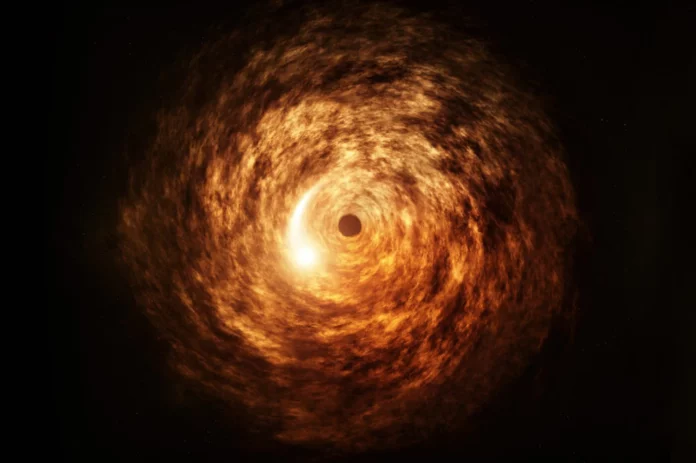Astronomers have detected for the first time a mid-infrared flare from a supermassive black hole at the heart of the Milky Way galaxy, and it sheds new light on the complex physics that govern these energy bursts.
A flare – a burst of energy whose intensity changes as the black hole’s magnetic field lines interact – fills in a region of black hole observations that had previously eluded scientists. However, questions remain about the chaotic environment near the heart of the bottomless object.
The detection and modeling of the outburst has been accepted for publication in the journal Astrophysical Journal Letters and is now available on the arXiv preprint server. The results of the study were presented today at the 245th meeting of the American Astronomical Society in National Harbor, Maryland.
The black hole, named Sagittarius A* (pronounced “A-star”), is an object with a mass about four million times that of our Sun and is located in the core of the Milky Way. Black holes are superdense objects with gravitational fields so strong that even light cannot leave their boundaries beyond a point called the event horizon. In the artist’s concept presented at the beginning of this article, a black hole is a dark abyss at the core of a vortex of matter.
“For more than 20 years, we’ve known what happens in the radio and near-infrared bands, but the connection between them has never been 100 percent clear,” said Joseph Michael, one of the paper’s lead authors and a researcher at the Smithsonian Astrophysical Observatory, part of the Center for Astrophysics at Harvard and Smithsonian Universities, in a press release from the center. “This new mid-infrared observation fills this gap.”
Mid-infrared light has longer wavelengths than visible light but shorter wavelengths than radio waves. This is also one of the specialties of the Webb Space Telescope, which it captures with the Mid-InfraRed Instrument (MIRI).
Cooling electrons in the accretion disk of a black hole – the superheated, incandescent matter surrounding the object – release energy to power flares. The role of electrons in black hole flares has been discovered in the mid-infrared wavelength range, and according to Mikhail, this is further evidence of what powers the flares.
The team’s detection and model provide greater clarity – and complexity – to the portrait of our galaxy’s central black hole. Modeling the physics of black holes and direct imaging of objects go hand in hand, bringing us closer to understanding the physics behind some of the most massive and prominent objects in our Universe.
In April 2019, the Event Horizon Telescope took the first direct image of a black hole, and in May 2022, it took the first direct image of Sagittarius A*, although last year a group of researchers suggested that this image was of poor quality.
Last year, a team of researchers whose telescope consists of a network of radio telescope observatories around the world made the highest resolution observation ever obtained from a planet. The work has shown that at certain wavelengths, future images of black holes could be 50% clearer than previously published images.
More observations may be needed to make sure that cooling high-energy electrons are indeed responsible for the flares. But this discovery offers a new twist to the story of black holes and demonstrates the role that the Webb Space Telescope can play in demystifying massive objects.









